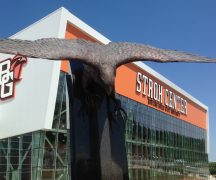By JULIE CARLE
BG Independent News
Title IX was enacted 50 years ago and changed the world of women’s sports.
A special exhibition at Bowling Green State University’s Stroh Center marks the 50th anniversary of the passage of Title IX and chronicles women’s sports at the university before, during and after Title IX. In fact, nearly 50 years before the 1972 legislation that prohibits sex-based discrimination in any education program that receives federal funding was approved, women at BGSU were actively involved in sports. As early as the 1920s, female students at the university were playing tennis, volleyball, softball, track/cross country, basketball, soccer and field hockey.

While women were a part of the university’s sports history, telling the story of women’s sports, especially in a visual context, has many challenges, said Allison Brandeberry and Jennifer Long Morehart, University archivists with the University Library’s Center for Archival Collections. The library and athletics partner to preserve and exhibit the athletic archival items.
The presentation on Tuesday to members of the Bowling Green League of Women Voters and other guests described the Heritage Hall display and the process and challenges to curate it.
“It has been difficult to show the stories of women’s athletics in the same way we tell the story of men’s sports,” Morehart said. “We often have a choice of potential artifacts telling the story of men’s sports, ranging from uniforms to equipment to trophies and more. It’s impossible to exhibit trophies and awards that never existed.”

Trophies and awards were not as prevalent in part because early women’s sports at BGSU emphasized lifelong health, socializing and good sportsmanship, not necessarily competition and achievements. Also, the opportunities were different for women and men, mostly because the women did not have the same resources.
“Fewer resources sometimes meant a lack of uniforms, using pinnies or the same uniform for multiple sports. It sometimes meant fewer opportunities to compete, which resulted in fewer artifacts from competitions,” Morehart said.
To offset the scarcity of artifacts, the archivists had to get creative in pulling together the first themed exhibit they would install in the Stroh Center space. They scoured the inventory of the (Mickey) Cochrane-(Don) Cunningham Archives, Janet Parks Collection, University Photograph Collection, Key Yearbooks and negatives, and the BG News.
They read “Forward Falcons: Women’s Sports at Bowling Green State University: 1914-1982” by Janet Parks, Ann Bowers and Adelia Hostetler Muti and they enlisted staff and students from the CAC and the Preservation Lab to help with research and resource scanning.
“The more we learned, the more our vision for the exhibit expanded,” Brandeberry said.
The resulting exhibition tells BGSU women’s sports stories with uniforms, equipment and trophies that have been preserved. To capture the essence of the missing artifacts, photographs, symbolic recreations, quotes and publication reprints are included.
“Each current varsity sport has its own materials unique to each sport and their achievements, but we also needed to illustrate the fact that almost all of the sports existed in some form at BGSU for many years — decades really — before Title IX,” Brandeberry said.
Early sports at the university were products of the physical education program and are represented in the display with a physical education uniform of Helen Day from the class of 1934 and a Women’s Athletic Association sweater of Mary Alice Penton, who earned the sweater in the 1940s.
“The contrast between Penton’s achievements and athlete achievements listed in the current varsity sports display cases helps to show the different philosophies behind women’s athletics at different points in history,” Morehart said.
“I tried to portray the value placed on socialization in much of BGSU’s women’s sports history. We have symbolized that with fake cookies and a carbonated beverage,” Morehart explained.
The displays for tennis, volleyball, softball, track/cross country, basketball and soccer reference the beginnings in the 1920s; the wins and achievements in intramural, extramural, club and intercollegiate games and tournaments; and stories of what it was like to compete during the Title IX transition.
Golf was introduced in the 1930s with the first women’s golf club formed in 1941. In 1974, the team claimed the Ohio Association of Intercollegiate Sports for Women team championship and in 1982 won their first NCAA Division I victory.
“They wanted to play. They wanted to win. We played with the big teams like Ohio State and beat them,” recalled Bowling Green resident Dolores Black, who coached the BGSU women’s golf team from 1969 to 1976.
Frieda Falcon has her own display case, complete with various incarnations, from the very unofficial Mrs. Freddie Falcon to the 1992 Frieda with her first pair of pants,” Brandeberry said. The first Frieda was created by the women’s basketball team because Freddie Falcon didn’t attend women’s events.
Legacy sports, including fencing, field hockey, lacrosse and the Swan Club, as well as club sports are represented in the exhibition.
“The club sports case helps to show that throughout BGSU women’s sports history, there are opportunities for both: competing at the highest level in varsity sports and playing for fun in club and intramural sports.” Morehart said.
The exhibit will be on display through the end of the year.





